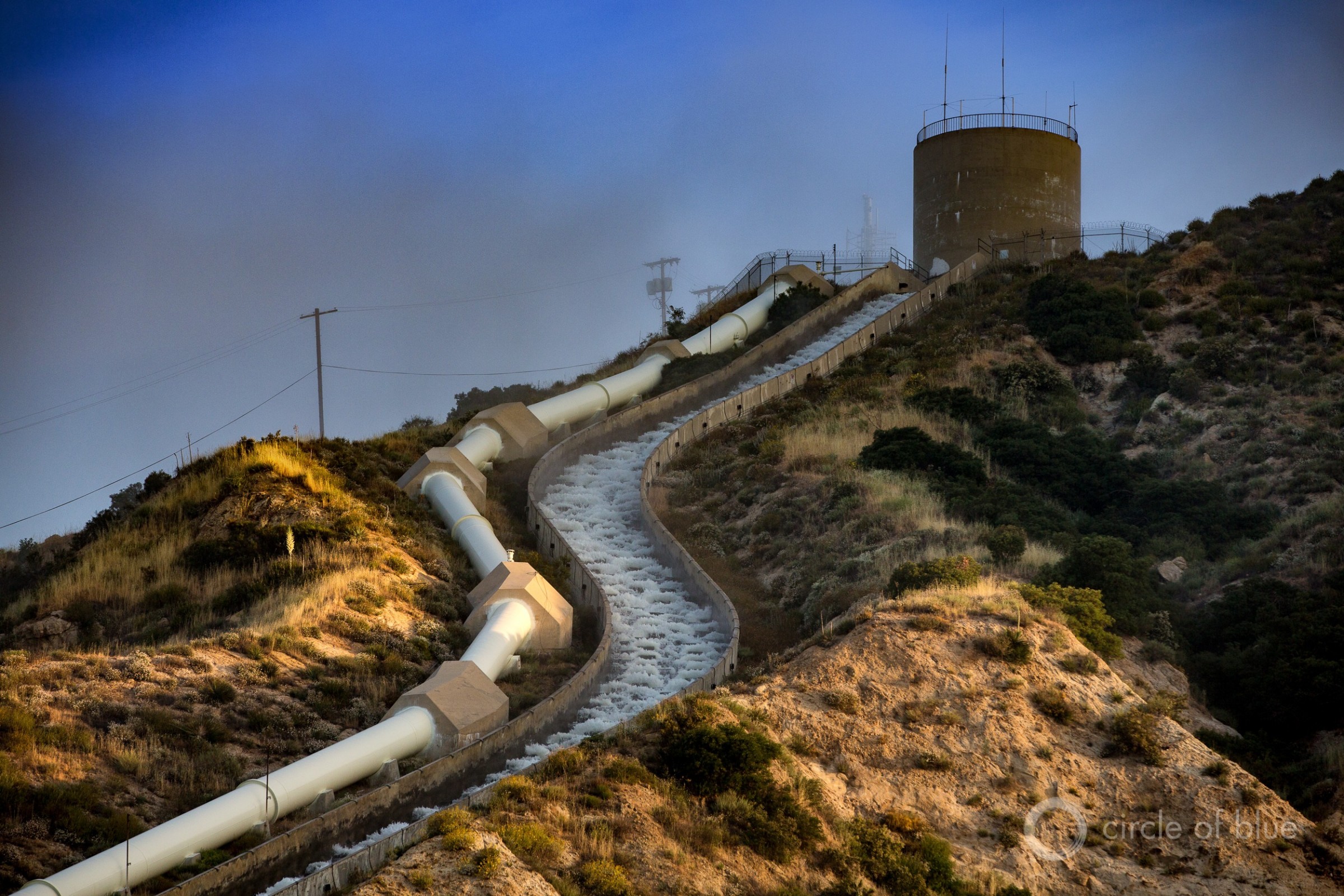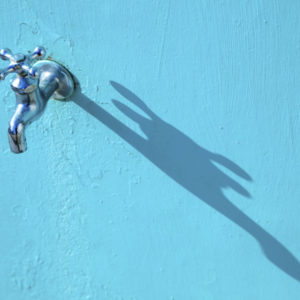The Stream, January 14, 2025: LA Water Dept. Sued Over Empty Reservoir; AI Data Center Worries Water-Stressed English Town; World Bank Doubles Down on Dams

The Los Angeles Aqueduct, photographed in 2017. Photo © J. Carl Ganter/Circle of Blue
YOUR GLOBAL RUNDOWN
- In Oxfordshire, England, two very different planned projects — a reservoir and an AI data center, to be built just seven miles apart — have the community questioning whose water needs are being prioritized.
- Though water levels in most southern California reservoirs exceed historical averages, the Los Angeles Department of Water and Power has been sued over the Santa Ynez Reservoir, which since last February has sat empty.
- Amidst Brazil’s Amazonian drought, some cattle breeders are caring for their starving herds by growing food — though paying for irrigation is proving costly.
- After largely abstaining from hydropower investments for the better part of a decade, the World Bank has shown a recommitment to funding dams in Tajikistan, Nepal, and Democratic Republic of Congo.
— Christian Thorsberg, Interim Stream Editor
Fresh: From the Great Lakes Region
Great Lakes Restoration Initiative (GLRI) Eyes Extension: After failing to receive Congressional approval before the end of the 2024 calendar year, a bipartisan group of U.S. representatives from the Great Lakes region have reintroduced a bill to extend the GLRI another five years, from 2027 to 2031, Michigan Advance reports. If passed, the initiative would authorize $500 million per year to protect and restore nearly one-quarter of the world’s freshwater. Funding would still need to be secured in the annual budget process. To date, “according to the Alliance for the Great Lakes, a nonprofit working to preserve the Great Lakes, the program has provided funding to more than 7,563 individual projects throughout the region to date, totaling $3.7 billion.”
Enbridge’s Final Report: The 24-page accident report, submitted by the energy company to the U.S. Department of Transportation on January 10, states that while 69,000 gallons of oil leaked from their Line 6 pipeline in early November in Jefferson County, Wisconsin, just 4.2 gallons reached a groundwater source, Wisconsin Public Radio reports.
The Lead
For evidence of the ongoing drought in the Brazilian Amazon, cattle breeders need look no further than the protruding ribs of their animals, whose feed and grazing areas have been severely impacted by the lack of rain in the region, Deutsche Welle reports. Facing desperate measures in the country’s northeast, breeders are making a concerted effort to grow more food — mainly corn — on their land, though irrigation demands are proving costly. They worry if such droughts continue, they will lose their animals, lose money on water costs, or both.
Recent WaterNews from Circle of Blue
- OPINION: Spreading Like Wildfire — How Misinformation About Water and Fire in Los Angeles Inflames the Situation
- Regulators Battle Oregon and Washington Farmers Over Limits to Farm Contamination — An effort to extricate Pacific Northwest states from mammoth pollution.
This Week’s Top Water Stories, Told In Numbers
117 million
Gallons of water the Santa Ynez Reservoir, located in Los Angeles, can hold — though it has remained empty since last February, according to a lawsuit filed on Monday against the Los Angeles Department of Water and Power, Reuters reports. Brought by the law firms Robertson & Associates and Foley Bezek Behle & Curtis, the suit claims that the department delayed repairs to the reservoir, thus causing it to remain empty, as a cost-saving measure. Though the department did not yet comment as of Monday evening, most reservoirs in southern California actually have higher water levels than historical averages. Reports over the weekend — in contrast to misinformation spread last week — have pointed to firefighters running short water supplies due in large part to the pronounced demand for the resource as the fires continue to rage, burning more than 40,000 acres.
$6.3 billion
The total cost to complete the construction of Tajikistan’s Rogun Dam, which is currently 30 percent built following its on-again, off-again progress since 1976. If complete, Yale Environment 360 reports, “it would become both the world’s tallest dam, at 1,100 feet, and with its total price tag of $11 billion, one of the world’s most expensive.” After supporting only one major hydropower project over the past 10 years, the World Bank — a major Rogun financier — has signalled that it is once again interested in funding dam-building. Last April, World Bank officials “agreed in principle” to help lead the financing of a $1.1 billion dam in Nepal, and are currently in negotiations over the building of the third dam of a seven-dam, $80 billion megaproject in the Democratic Republic of Congo.
On the Radar
A new artificial intelligence data center, the first of its kind in England, will be built just seven miles from a planned reservoir meant to serve a water-stressed region of Oxfordshire, the Guardian reports. Because these centers have already been shown to consume large amounts of water — between 1.8 and 12 liters for each kilowatt-hour of energy — there are growing concerns that the Labour party’s bullishness for AI development will come at the direct cost of in-need communities. According to England’s Environment Agency, the town of Culham and its surrounding areas are the country’s most at-risk for running out of water. During periods of drought and heatwaves, the community has relied on bottled water for its needs.
According to the Guardian, by 2050, without factoring in the water usage of AI data centers, England is projected to experience a “shortfall of nearly 5 billion liters of water a day between the sustainable supplies available and the expected demand.” By 2027, one study projects that the global water needs of AI could eclipse two-thirds of England’s annual water usage.
49th State Focus: No Bids for Arctic Refuge Oil Drilling Lease
“The lack of interest from oil companies in development in the Arctic National Wildlife Refuge reflects what we and they have known all along: There are some places too special and sacred to exploit with oil and gas drilling.” — Laura Daniel-Davis, the acting deputy secretary of the Interior Department.
This is the second failed sale in four years, though there may be a third if Alaska Gov. Mike Dunleavy is successful in court. The state of Alaska sued the Biden administration on Monday, saying that the size of the proposed leasing area — listed at 400,000 acres, the minimum mandated by Congress — made the lease economically unviable for any company wishing to drill. “If Alaska is successful in its lawsuit, the Trump administration could potentially redo the sale and offer more land,” the New York Times reports.
The Arctic National Wildlife Refuge comprises 19 million acres of northeast Alaska’s North Slope. Though conditions are cold and harsh in the winter, the land boasts lush greens and blues in the summer months. Home for caribou, polar bears, musk oxen, dall sheep, and millions of migratory birds, the refuge’s coastal plain contains some of the largest wetland ecosystems in the country, extensive river ice networks, and the two largest alpine lakes on the continent. Hardly a wilderness, the refuge’s ecosystems are held sacred by Gwich’in peoples, who have lived on the lands and waters for generations.
Christian Thorsberg is an environmental writer from Chicago. He is passionate about climate and cultural phenomena that often appear slow or invisible, and he examines these themes in his journalism, poetry, and fiction.








Leave a Reply
Want to join the discussion?Feel free to contribute!